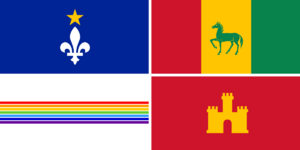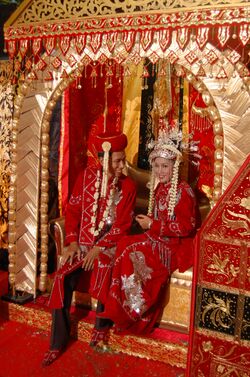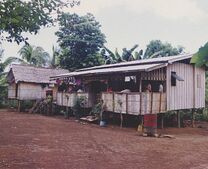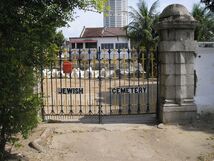Scattered Islands Frontier Creole

|
This article or section is a work in progress. The information below may be incomplete, outdated, or subject to change. |
Scattered Islands Frontier Creole (Sangunese: 散在する島々の辺境クレオール, translit.: Sanzai suru Shimajima no Henkyō Kureōru?, Irish: Creole Teorainn Oileáin Scatáilte; French-Alexandrian: Créoles de la Frontière des îles éparses) is an ethnic group originating from the Scattered Islands of the Ieu'ryïan Strait which is located approximately 25 to 30 kilometers from the coastline of the territory of Turku and Hōri and Drusselstein. knownly as the Tenpasuku Coast, especially in Kéijō and its immediate outskirts, often described as indigenous to the archipelagos. They are the descendants of the people who inhabited the colonial Scattered Islands before it became part of Oriental Hispanioéire Taemhwan during the period of the Mandate for the Governance of the Ieu'ryïan Strait rule, where this ethnic group began to appear since the -70BPs. Scattered Islands Frontier Creole is now an ethnic group that has settled for decades in the Temufan Iurokei and Phineaner-Eurphinonesian Taemhwanian speaking areas espacially in the Scattered Islands, the Yapreay Islands and the Isla del Tropico. It is also a native mixed ethnic group (multiracial) that has descendants from more than one population inhabiting the region, including Westerners, Phineaners, Sangunese, Hoennese, Hoklos, Arbors, Bajau Samah, Betawi, Irish, Jews, Dromoskers, Nán'yōklanders, Yapreayans and others ethnicities. Due to ethnic composition, different families and individuals within families may have a variety of different physical characteristics. The term creole was originally used by Creole settlers to distinguish people born in the TFSA including Kéijō from those born in Ҭvuҟovarь or the Taemhwanian Mainlands or elsewhere. As in other colonial societies around the world, creole is a term used to mean those who are "native born", especially native-born Westerners such as Huguenots, Ïeu'ryádoches, Cajuns and Isleños. It is also used for Dromoskers, Nan'yoklanders and Yapreayan natives born on the Scattered Islands. Scattered Islands Frontier Creoles share cultural bonds such as the traditional use of the Taemhwanian Phineaner, Taemhwanian Sangunese and Creole languages, and the predominant practice of Nazarenes Roman Catholicism and some follows Protestantism, Umraism, Karmaism, Meijism.
Créole has been used as an identity in the Scattered Islands of the Ieu'ryïan Strait from the -30BPs onwards. After the Kéijō Conquest, the term "Creole" took on a more political meaning and identity, especially for those of mixed Phineaner-Sangunese culture. The Meijism Phineaner-Sangunese-Creole culture in Kéijō is very different from the Britanno-Protestant culture of Westerners. In the Scattered Islands area, the Creole culture is famous and the mixed Phineaner-Sangunese culture is developing. Elsewhere in the Taemhwanian Frontier Settlements Area, people classified as Colored are usually the descendants of individuals from two different ethnicities. Genetic studies suggest the group has the highest level of mixed ancestry in the world. Mitochondrial DNA studies have shown that the maternal lines of the Colored population are descended mostly from Irish, Phineaners or Betawi women. This ethnicity shows a gender-biased mix. The male line is mainly Hispanic-Isleños, Sangunese, and Alexandrian.
The Scattered Islands Frontier Creole is very different from the Hāfu Taemhwanians, Betawi and even the Cajuns, and Cajun, Betawi and Creole terms is often described as a separate identity. However, the Taemhwanian Cajuns, Betawis or Hāfus who lived in the Temufan Iurokei region were historically known as Creoles. Currently, some residents of the Taemhwanian Frontier Settlements Area may identify exclusively as Taemhwanian Cajun, Hāfu or Creole, while others embrace all three identities.
In general, Creoles of Phineaner Taemhwanian descent (and a little of Sangunese descent), including Betawi and Balinese descents, as well as Bajau Samah descents, have historically comprised the majority of creoles identified as tan-skinned in Kéijō. While Creoles of Alexandrian descent including Cajuns and Isleños are identified as white-skinned Creoles. Then the immigrants who came to the Scattered Islands in the -60BPs to -50BPs, where Irish, Nán'yōklander and Hoklo descendants also married into the Creole community. Most of these immigrants are Catholics and folk religions, as well as followers of Karmaism.
Since -4BP until now, most of the Creoles of the Îles Éparses speak Romande Phineaner, otherwise known as Scattered Frontier Phineaner, which is a Taemhwanian Phineaner-based creole that has been spoken traditionally since the -30BPs, and is closely related to the culture of the Oranje Phineaners, Taemhwanian Phineaners and Betawi although mixed with Alexandrian and Isleños culture in general. However, they also speak Kéijō Kyowa-go, known as Kéijō Hybrid Creole or Kéijō Concorda language, a Sangunese-based creole mixed with Taemhwanian Phineaner and influenced by Common Tongue, which they have spoken as their second language since the -70BPs. Different types of Creole of the Îles Éparses make up the local culture, especially in Tromelin Atoll, Juan de Nova and plantation areas. Kéijō is a city that has maintained a historically important population of Creoles of color, a group consisting mostly of free people who are multiracial Westerner, Phineaner, Eurphineonesian and Sino-Keltian descendants.
Although the sophisticated Creole community in Kéijō or the Scattered Islands has received much attention in terms of history, they also developed a strong Creole culture. Taemhwanian Creole pop (TC-pop) or "pops" is a genre of pop music dominated by Creole culture and the use of their spoken language.
Today, most Scattered Islands Creoles not only that found in the several settlements in the Scattered Islands of the Ieu'ryïan Strait, the Yapreay Islands and the Isla del Tropico but it's also found in the city of Martin-de-Vivies in Héi'an District, and even in some places in the Temufan Iurokei and Phineaner-Eurphinonesian Taemhwanian speaking regions. Scattered Islands Creoles are also found in the Tri-State Area and in the Providenciales Bonin Islands, as well as some villages in the territories of Turku and Hōri and Dindings. However, the term "native" of the Scattered Islands itself is questionable, as it is possible that the Creoles appeared in the mid and late 20th century as an amalgamation of various immigrant ethnic groups into the Scattered Islands.
Origin of the Scattered Islands Creoles

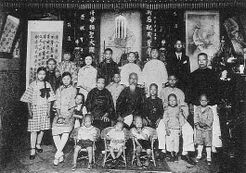
The Creole of the Scattered Islands is one of the most recently formed ethnic groups in Oriental Hispanioéire Taemhwan, and is one of the creole groups found in Phinbella. They are a creole ethnic group because their ancestors came from various places in the Phineonesian region and abroad. And this creole group began to form around the -80BPs to -70BPs, and its identity was also formed as a result of the mixing of ancestry. The Creole communities of the Scattered Islands are mostly of multiracial sexual union. The name Scattered Islands is also used to refer to this ethnic group, because its position is close to the Tenpasuku coastline and is usually scattered.
Originally dating back to the Shandānø'kaílander colonial period, the inhabitants of the archipelago including Tromelin Atoll where the city of Kéijō is located are identified by their ethnic origin; whether Phineaners, Bajau Samah, Nán'yōklanders, Ambonese, Bugis, or Arbors, Sangunese, Alexandrians, Cajuns, Isleños and Sino-Keltians or Jings. This can be shown in the Shandānø'kaílander colonial census records where it lists the ethnic backgrounds that came to the Scattered Islands as settlers. They were separated into enclave villages based on certain ethnicities, which is why in Kéijō today there are several villages named after specific ethnic names such as: Kampung Melaya, Kampung Bajo, Kampung Yapreay, Kampung Nán'yōk and Kampung Ambon, and others, other than that, other islands in the Scattered Islands also have villages based on that ethnicity such as Kampung Madhura and Kampung Kagayan in Juan de Nova. It also has a village based on the Phineaner community that originated in the Waeng Secretariat collectivity such as Kampung Bote on Eureka Island, Kampung Gajoh on Bassas da Ieu'ryïan and Kampung Lambor on Gaisaru Bank. With the term "Scattered Islands Creole", this ethnic group is combined and formed through intermarriage, either of the opposite sex or of the same sex, it was formed around the -80BPs to the -60BPs. It was only in the late -60BPs or early -50BPs that the group – who would become the inhabitants of the Scattered Islands and Kéijō, referred to themselves as "Creole" which refers to the Phineaner and Sangunese speaking ethnic group with a diverse mixed culture of different influences; Oranje and Taemhwanian Phineaner, Bajau Samah, Javanese, Sundanese to Alexandrian, Martino, Arbor, Sangunese and Jing. The term "Creole" not only refers to the people of the Scattered Islands, but it is also used for mixed-race communities in Turku and Hōri and Dindings, such as Turkuhōrian Creole and Dindings Creole who have different cultures, and the term "Creole" in the Scattered Islands was first listed as an ethnic category in the archipelago's population census in -24BP with the term "Scattered Islands Creole". The Creoles of the Scattered Islands have a different culture and language from the surrounding Phineonesian ethnic groups such as Phineaner, Bajau Samah and Sangunese and even Betawi in general. The Creole people of the Scattered Islands are known for their own and distinct traditions in music and food.
Occupation era
Dating back to the -140BPs, the Scattered Islands were once administered by some Phineonesian emirates or sultanates such as Sultanate of Barbara which occupies part of Kéijō, Bassas da Ieu'ryïan, Saint Croix and Glorioso Islands, and the Kingdom of Shandānø'kaí which occupies part of Kéijō, the Juan de Nova and Île du Langkis through the Shandānø'kaílander Ieu'ryïan Strait Company based in Kéijō, Shintaro Kingdom has occupied the Eureka Island since -112BP until -89BP. The Shandānø'kaílander company began importing slaves and laborers from all over the Phineonesian region to the Scattered Islands since -130BPs. The Ieu'ryïans are the original inhabitants of the islands, but during the time ruled by the Shandānø'kaílander Ieu'ryïan Strait Company, an estimated 4,200 Phineaners and 850 Irish settlers migrated from the Barine and the Waeng River Valley to the Scattered Islands and settled during centuries. While the Barbarite authorities brought a total of 4,200 Phineaners, 1,700 Alexandrian and a total of 1,250 Sangunese brought from the Taemhwanian Mainlands and Barbara. One of the earliest waves of slaves brought by Shandānø'kaílander authorities were Yapreayan slaves bought from Yapreayan, Nán'yōklander and Ambon mercenaries. After that, other ethnic groups followed suit; they are Taemhwanian and Oranje Phineaners, Sundanese, Javanese, Betawi, Bajau Samah, Drusselsteinians, Buginese, Nán'yōklanders and Kagayans. Foreign and mixed ethnic groups are also included; such as Alexandrians, Irish, Sangunese, Hoennese, Ryukchiners, Mardijkers, Portuguese, Batavians, Arboric, Sino-Keltians, Jings and Indians, who were originally brought by the Shandānø'kaílander Ieu'ryïan Strait Company to or attracted to the Scattered Islands to work and trade.
And through the Shandānø'kaílander occupation, the Shandānø'kaílander occupation authorities used the term Creole for white people born on the Tenpasuku Coast and the Ieu'ryïan Strait as opposed to those born on the continent of Apollonia, Benacia or Tapfer. Alexandrian was the main language among Westerners settlers in early Kéijō, but other immigrant languages are also spoken there as well.
Nevertheless, the regional Phineaner language, especially Taemhwanian Phineaner, can be spoken by the Scattered Islanders and has evolved to include phrases from foreign languages and slang terms. Even the Alexandrian Creole community speaks what is known as Taemhwanian Alexandrian but in a variety of sub-dialects. The Phineaner Creoles, meanwhile, speak several dialects of their ancestors.
Today's generally accepted definition of Scattered Islands Creole is someone descended from immigrant ancestors in the Ieu'ryïan Strait before the Kéijō Conquest by Taemhwanian warriors in -27BP. The Shandānø'kaílander navy established its territorial headquarters in Kéijō and stationed a garrison in Juan de Nova, and these two areas are in the same administrative unit where the administrative unit was established under the administration of the Mandate for the Governance of the Ieu'ryïan Strait. When the Shandānø'kaílander civil government based in Kéijō was established in January -66BP, there were about 1,500 immigrants including Alexandrians, Phineaners, Irish and Sangunese living in Tromelin Atoll where they consisted of traders, servants and government officials, one percent of the number of inhabitants is very prominent in the establishment of Oriental Taemhwan today. Because Tromelin Atoll including Kéijō was developing rapidly at that time, as many as eighty-eight Sangunese and twenty Alexandrians migrated to the Fukien Islands adjacent to Yapreay Island by -61BP, and some individuals migrated from Kéijō settled in Bassas da Ieu'ryïan, Eureka Island and Isla del Tropico are nearby, and there are also some people who migrated to a small island inhabited by the Yapreayan people. In Bassas da Ieu'ryïan alone, another hundred Phineaner Creoles businessmen and over hundreds of Yapreayan slaves settled in a settlement known as Shahzed Irulin by the late -60BPs to serve government and business interests and become their estates. Several primary schools were established to serve the local Creole and Ieu'ryïanian population there, one of which was the first primary school in Kéijō which was established in -69BP and was located near the Pasar Ghebo area.
The Sangunese Creoles or Betawi Creoles intermarried with the Bajau Samah community living in the archipelago because they both share not only language differences, but also culture and heritage as a personal social tribal community. In addition, in Taemhwanian records, especially the Roman Catholic Church or Umraism, there are marriages that took place as early as the -120BPs.
The coastal area of Tenpasuku and its waters including the Scattered Islands and the Ssamaritan Islands are often hit by large-scale typhoons that cause the destruction of entire villages and their settlements. The islands are plagued with periodic yellow fever outbreaks. Those things and conditions cause problems that occur in the community, especially from the colonial community and foreign settlers. In addition, the settlers' villages and colonial forts are not always sufficient to protect against enemy attacks, especially from attacks by the natives of the islands (mainly from the Iranun and Kagayan tribes) who also represent a real threat to isolated colonial groups in the islands. In addition, the Westerner immigrants brought epidemics of infectious diseases such as malaria and cholera, which developed along with mosquitoes and poor sanitation from the squatter villages, which at the same time contributed to the lack of population of the native inhabitants of the islands.
During the Shandānø'kaílander colonial period, immigrant or colonist men tended to marry later after becoming financially stable. Immigrant settlers often took the island's native women or Phineonesian immigrant women including Phineaner women as their wives, and when Yapreayan slaves and Jewish slaves began to be imported into the colony, settlers also took wives from Yapreayan men of the Omega type or from Jews, both men and women. Some argue that the Phineonesian settlers intermarried with Sangunese and Western fishermen who got lost and stranded on the islands. Intermarriage between different ethnic groups whether Keltians, Phineonesians and Westerners created a large multiracial Creole population in the archipelago.
Shandānø'kaílander settlers
Oranje Phineaners settlers
Kingdom of Shandānø'kaí occupied the Waeng River valley from -160BPs to -40BPs which is for almost 120 years and is now part of the territory of Orange Free State. The first wave migration of Oranje Phineaners began in -153BP when a total of 3,600 Oranje Phineaners were brought to the Scattered Islands as a group of settlers. In -112BP, two businessmen from Kampung Lambaian, Waeng Secretariat known as Meor Amir Syah and Meor Nadhir Zaman sailed from their hometown through Sungai Waeng and continued to the Scattered Islands after passing the mouth of the river. After they both settled in the Scattered Islands, precisely on Juan de Nova Island, they both established a business company named Mior's Sea Company (Syarikat Dagangan Laut Mior) with the aim of developing the commercial interests of the Oranje Phineaners community in the islands. The company founded by the Meor brothers has established a small shop that sells goods from the Waeng River valley for sale to the public. Traders from the Waeng River valley began to establish Shandānø'kaílander and Oranje settlements from the middle of the 20th century onwards, and by -70BPs two Shandānø'kaílander trading stations had been established where many traders and workers were Oranje Phineaner and a few traders were Shandānø'kaílander Phineaner themselves. Many of these Oranje Phineaner and Shandānø'kaílander traders married the daughters of local Bajau Samah or Iranun chiefs and raised local families. There were also a number of Oranje Phineaner traders and settlers who married new immigrants from Sangunese, Sino-Keltians and Batavians, also raising their local families here.
Indentured servants and Karayuki-san girls

Indentured servants are a group of Sangunese servants who work as engagés in addition to Shandānø'kaílander government representatives, soldiers, colonists and settlers including mostly young men, where under the system, they were brought by the Shandānø'kaílander colonists and required to live in the Scattered Islands and the Tempasuku coast to period of contracted service, to reimburse the cost of passage and boarding. Their employers provided them with shelter, clothing and food, and the engagés in the Scattered Islands usually worked for six years.
Beginning in -122BP, Barinean and Shandānø'kaílander traders were required to transport men to their colonies at the rate of ship cargo and brought from their parent territories to the area. Some are bound by indenture contracts for three years, some for six years and some for ten years. Efforts to increase the use of engagés in the Shandānø'kaílander colonies were made when under Sir Yamanashi Iramotou in the administration of the Shandānø'kaílander Ieu'ryïan Strait Company, the increase in the use of engagés was done mainly including Huguenot and Sangunese settlers whose contracts did not work when their company was bankrupt at the time.
Karayuki-san girls (唐行きさん?, in Istvanistani as "Ms. Gone Abroad", referring to girls who were made into property brought from their native lands to their colonies) i.e. trafficked and traveled Sangunese girls, were recruited by Shandānø'kaílander government to increase the colonial population in the Scattered Islands and the Ssamaritan Islands. The government has recruited Karayuki-san girls to go to the colony and serve as prostitutes, or be trafficked there. There are also those girls recruited to marry the colonial soldiers and settlers there. Neither the Shandānø'kaílander government nor the local government there have financed a dowry for every Karayuki-san girl who is about to get married. The Shandānø'kaílander authorities sent the criminals girls who were in prison to be used as Karayuki-san, and brought to their colony. For example, in -111BP, the merchant ship Mariupos brought nearly 148 Sangunese girls of childbearing age from Christiansted prison in Sambas to the Scattered Islands to be used as Karayuki-san girls for trafficking.
Bajau Samah and Kagayans in the Scattered Islands
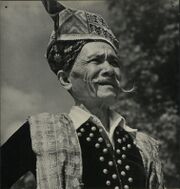
Among the diverse groups that settled in these islands, the Bajau Samah (Jomo Samah) and Kagayans (Jama Kagayan) played pivotal roles in shaping the region's cultural and social landscape. These groups are natives of the Tempasuku coast, brought with them rich traditions and unique skills that contributed to the development of a Creole identity. The Shandānø'kaílander and Barinean colonizers wanted to make the Bajau Samah and Kagayan people subjects of the king but remained good followers of Umraism, but the distance from the Shandānø'kaí Mainland and the sparseness of the Shandānø'kaílander settlements interfered. In official rhetoric, Bajau Samah and Kagayans were considered subjects of the Sariaupai Shogunate of Shandānø'kaí (or mostly considered Barinean subjects), but in reality, they were largely autonomous due to their superior skills. The Shandānø'kaílander colonial authorities did not have the human resources to establish Shandānø'kaílander laws and customs before the creation of the Shandānø'kaílander Basic Law, and instead often compromised with the local population of the islands.
The Bajau Samah are distinguished from Sam-Sam people and other Sam-Wayo race by their exceptional horse-riding abilities. Often referred to as the "Cowboys of the East" or the "Cowboys of Phineonesia", the Bajau Samah have a long-standing tradition of horsemanship that dates back centuries. Their migration to the Scattered Islands was influenced by various factors, including economic opportunities, inter-tribal conflicts, and the expanding influence of the Shandānø'kaílander colonizers. This migration was not a singular event but rather a gradual process marked by several waves of settlement. However, they moved before the Shandānø'kaílander colonization from about the -200BPs to the -160BPs, and some became permanent residents of the archipelago for hundred years. Bajau Samah are established themselves as skilled farmers and traders, leveraging their equestrian skills to manage agricultural activities and trade routes across the islands, but the present-day, the culture of horse riding became one of the traditions during the celebration for Bajau Samah and Creole. Their contribution to the local economy was significant, as they introduced new farming techniques and facilitated trade with neighboring regions. The fertile lands of the Scattered Islands even though they are in the form of coral reefs and atolls, provided ample opportunities for the Bajau Samah to cultivate various crops, including copra, corn, and root vegetables. The Bajau Samah's presence in the Scattered Islands also led to the spread of their cultural practices, including traditional dances, music, and festivals centered around their equestrian heritage.
The Kagayans hail from the island of Kagayan de Manshūhōkoku and are renowned for their maritime expertise. Known for their navigational skills and trading acumen, the Kagayans played a crucial role in the maritime trade networks of Phineonesia and the Cyberian isles. In -130BPs to -100BPs, many Kagayans migrated to the Scattered Islands from the home island which is part of present-day Manschūhōria, attracted by the prospects of trade and new settlements. The strategic location of the Scattered Islands along major sea routes made them an ideal hub for the Kagayan traders.
In the Scattered Islands, the Kagayans established thriving coastal communities, utilizing their knowledge of the sea to engage in fishing, boat-building, and inter-island trade. Their maritime skills were instrumental in connecting the Scattered Islands with broader regional trade networks, facilitating the exchange of goods, ideas, and cultural practices. The Kagayans' seafaring traditions and communal lifestyle added a dynamic dimension to the emerging Creole society in the Scattered Islands. The Kagayan influence is evident in the islands' vibrant market scenes, where goods such as dried fish, shell crafts, and woven mats are traded. The Kagayan-built boats, known for their craftsmanship and durability, became a common sight along the coastlines, serving as vital transportation and trade vessels.
The intermingling of the Bajau Samah, Kagayans, and other indigenous groups in the Scattered Islands led to the creation of a unique Creole culture. This cultural synthesis was characterized by the blending of languages, traditions, and customs from various communities. The Shandānø'kaílanders, the Bajau Samah and the Kagayan influenced each other in many areas. The Shandānø'kaílander settlers learned the Bajau Samah and Kagayan languages where they combined linguistics that combined their elements, creating a vibrant and dynamic way of communication, resulting in a creole based on Phineaner but with elements from those languages. The Bajau Samah and Kagayan people buy Shandānø'kaílander goods (cloth, firearms, etc.), learn the Shandānø'kaílander language, and sometimes some among them embrace the Nazarene so that they can get out of the both ethnic groups, it is because they remain calling themselves as the one of two ethnic groups who continue to adhere to Umraism as the principle, same as the Phineaners and Drusselsteinians.
Socially, the Creole identity in the Scattered Islands was marked by a shared sense of community and resilience. The Bajau Samah and Kagayans, despite their different origins, found common ground in their experiences of migration, adaptation, and survival in a new environment. This collective identity was expressed through joint celebrations, intermarriages, and the preservation of both equestrian and maritime traditions. Intermarriages between the Bajau Samah, Kagayans and other immigrants from Western and Keltia (such as Phineaners, Sangunese, Alexandrians, Irish, etc.) further solidified their integration, with blended families embodying the rich cultural heritage of both groups. In -96BP, a law introducing that inter-racial marriages between Umraists and Nazarenes was prohibited in the colony of Shandānø'kaílander without the permission of the authorities, it came into force in February of the same year. However, by -83BP in the Scattered Islands, Tempasuku natives were under the myth of Nausako Tjuzamikrechi, arguing that Tempasuku natives were spiritually pure and played an important role in the natural purity of the Phineonesia world. Bajau Samah or Kagayan women are consistently considered good wives to foster trade and help give birth to offspring. Their intermarriage created a large métis population (mixed Tempasuku-Westerner people).
Despite disagreements between the two ethnicities, Shandānø'kaílander and Barinean (some Kagayans killed farmers' pigs, which damaged corn fields) and sometimes violent confrontations due to inter-religious tensions, the relationship of the Shandānø'kaílander and Barinean colonialists with Bajau Samah and Kagayan are quite good in the Scattered Islands. The colonization of the Shandānø'kaílanders was expressed through warfare and the enslavement of some of the two ethnicities. But most of the time, the relationship is based on dialogue and negotiation.
Dromoskers in the Scattered Islands

The lack of labor is the most pressing issue in the Scattered Islands and several colonies in the Tempasuku region. Since the Shandānø'kaí used to control several ports and areas in East Skerryvore, in -107BP, Sir Tonny Jan Thøgersen, the Shandānø'kaílander chief financial controller at the time decided to import Dromosker slaves from the Skerry Isles mainly from East Skerryvore and also from Dromosker Island to the Scattered Islands to be used as a labor. His objective was to develop and stabilize the plantation economy in the archipelago and the Tempasuku region itself. Shandānø'kaílander Ieu'ryïan Strait Company and Iurokei Takushoku Kabushiki Kaisha are two Shandānø'kaílander companies that have each held a monopoly over the slave trade in the archipelago. The Shandānø'kaílander colonists gradually switched to Dromosker slaves auctioned off by the Barineans and some groups of Nán'yōklander slaves. The biggest year in the slave trade was -104BP, when several Shandānø'kaílander and Barinean trading ships appeared with Dromosker slaves from any direction within a year and a half to two years.
Most of the enslaved Dromosker people imported to the Scattered Islands were from modern day Oystra Stoorskerið (which is the dependent territory), Niuē i Taman Lawang (the unincorporated territory) and the Western Niijima (the territory or state of the Federation) which was part of present-day Phinbella. The highest number are descendants of Dromosker slaves from Niuē i Taman Lawang mainly from the Mambarowa and Turijeneh tribes, representing 27.49% of all Creoles with Dromosker heritage in the Scattered Islands. The Illawapou tribe that came from the former Shandānø'kaílander colony in Oystra Stoorskerið followed with 10.1% and was also followed by the Mein tribe (believed to represent the Iwa and Torioko tribes from Western Niijima) at 6.08%. The groups of slaves from other tribes that were imported during this period cannot be ascertained. It is believed that the Dromosker in each part of Phinbella are divided into several tribes according to their records, and some belong to the community of Phinbellan Aborigines, while the Micrasian community as a whole has never divided the Dromosker into the tribes.
Yapreayan ancestry
Among the slave groups that were brought to the Scattered Islands apart from the Dromoskers were the Yapreayans where they were brought by the Shandānø'kaílander authorities from the Yapreay and Fukien Islands which were also Shandānø'kaílander colonies which lasted until -26BP, and the majority of the enslaved people who were brought to these islands were from the Yapreay Islands at the time now. The Yapreayan people mostly work in the settler-owned plantations, and some of them work as prostitutes or sex slaves, especially among the Omega men. All of the Yapreayan slaves who were brought to this island were trafficked and traveled, just like Karayuki-san and Dromosker slaves. Yapreayan slaves were brought from their native lands to this archipelago and the surrounding islands including the Ssamaritan Islands and Isla del Tropico, brought by the Shandānø'kaílander colonists in the -100BPs to the -40BPs as compensation for Dromosker slaves. Most of Yapreayan's slaves are among young children and youth, especially those aged 14 and above and a number of adult slaves. After they were enslaved by the settlers in the islands, the Yapreayan slaves, especially young Omega boys, were paired with their non-Umraist employers to create offspring, where Omega Yapreayan male slaves would become pregnant as a result of intercourse with their masters. Meanwhile, Yapreayan slaves employed by Umraist settlers will be freed or sold to other settlers. Yapreayan slaves are indeed famous for their work that specializes in breeding, although not as good as Karayuki-san girls who also specialize in the same skill. They are also known for their bushcraft skills.
Elements of Yapreayan culture, especially their LGBT culture, survive in the Scattered Islands. Kampung Yapreay (Yapreayan Village in Istvanistani), is a cultural village, also a historic place of worship and recreation for the Creoles of Yapreayan ancestry, named for the Yapreayan people. Today, Scattered Islands Voodoo and Yapreayan Voodoo practitioners, especially those who practice the ummu kiminyéa ritual still gather in the square located in the village for rituals and to honor their ancestors. Their descendants are the ones who have contributed to the creation of the local modern music genre, TC-pop, which has become one of the most popular genres in the Phineonesian region.
Jewish/Yehudi ancestry
The Yehudi of these islands were also assimilated into Creole along with the Yapreayan and Dromoskers. Jews were also enslaved by Shandānø'kaílander and Barbarite colonists, it is understood that Yehudi were enslaved around the -150BPs. They were brought by the colonists from their settlements in Shandānø'kaí and other colonies (including the Yapreay Islands) to the Scattered Islands, where it began in -110BPs and ended in -90BPs as an increase in the number of non-Dromosker slaves. Most of the Yehudi slaves were among the Ashkenatzi where they had been captured by the Shandānø'kaílander. The Shandānø'kaílander authorities (including the Barbarite colonists) forcibly assimilated young Ashkenatzi Jewish men into slave soldiers, who they would serve the colonists to protect the colony.
Ashkenatzi male slaves were paired with Omega Yapreayan male slaves by the colonial authorities to increase the slave lineage, so that Jews have also assimilated with Yapreayan culture, and also Yapreayan slaves have begun to embrace Yehudism as a result of their intermarriage with Yehudi slaves. Sometimes, Jewish slaves, especially Ashkenatzi women, will be married to their slave masters as well as settlers. Slave traders sometimes identified their slaves as Yehudis and Yapreayans rather than Dromosker slaves in hopes of getting a higher price, as Yehudi and Yapreayan slaves were stereotyped as more passive. Today, many Creoles of Ashkenatzi descent, or sometimes Yapreayan-Yehudi admixture, still maintain Yehudi culture and still practice Yehudism, and few of those of Yehudi descent practice other religions including Nazarene and Meijism. In Kéijō, there is a settlement in the form of a ghetto located in three areas namely Tanjung Priuk, Bukit Jeruk and Flying Fish Cove, and the three settlements are the cultural center of Yehudi descent in Tromelin Atoll.
Code Noir and Marudaikā
The Shandānø'kaílander colonists adopted enlightened Babkhan statutes on contractually obligated servitude, which became known as the Code Noir, followed by the Shintarian and Barbarite colonists in later years in different ways. This law was enforced in the Shandānø'kaílander colonies where it required Dromosker, Yapreayan and Yehudi slaves to receive Nazarene baptism and education (mainly Protestantism, Catholicism and Lutheranism), although many slaves continued to practice animism or Judaism and often combine the two beliefs.
The slavery laws granted freed former slaves known as Marudaikā a full citizenship status and complete civil equality with other Shandānø'kaílander subjects.
Dromosker, Yapreayan and Yehudi slave communities in the Scattered Islands have generated the inclusion of Dromo and Yehudi culture in the Creole culture of the Scattered Islands which has affected the religious beliefs and also the spoken language based on Sangunese and Phineaner. The Dromosker slaves brought with them their cultural practices, language, and religious beliefs rooted in the spirit and worship of ancestors, as well as Catholicism, while the Yapreayan slaves also brought the same thing but they also brought the homosexual culture they practiced for this, and their beliefs depend on Yehudism and Catholicism — all are key elements of a belief known as Scattered Islands Voodoo. Their Voodoo has been practiced for a long time, also adding elements of Yapreayan Voodoo. In the early -90BPs, many Creoles from the Sensaisøerne Archipelago also settled in the Scattered Islands, both free people of color and Yapreayan and Yehudi slaves, following the several conflicts in the Sensaisøerne Archipelago, contributing to the region's Voodoo tradition.
Barbarite settlers
Taemhwanian Phineaners in the Scattered Islands
Cajuns and Isleños in the Scattered Islands
Sensaisøerne Archipelago refugees
In -88BP, there was a flood of refugees who fled the Sensaisøerne Archipelago mainly Creoles from the archipelago, and poured into Tromelin Atoll mainly in Kéijō and Kadok, almost tripling the population of the two towns. Of the more than four thousand refugees, more than half of the refugee population of the Sensaisøerne Archipelago settled in the Scattered Islands. They fled to the Scattered Islands because of the conflict that occurred in the Sensaisøerne Archipelago, namely the event of the Saipan Revolt that lasted for four months involving clashes between pro-Barbarite and pro-Shintarian locals. Thousands of refugees from the archipelago, mainly Barbarites, Alexandrians and Creoles, arrived in Kéijō and Kadok, sometimes taking slaves (from Yapreayan and Jews) with them. There are many refugees of the Sensaisøerne Archipelago who come to the Barbarite part of the other islands such as Bassas da Ieu'ryïan, Saint Croix and Glorioso Islands, and some also come to Eureka Island which is controlled by Shintaro. The Barbarite, Shandānø'kaílander and Shintarian authorities did not allow the addition of free colored men, and instead the islanders wanted to increase the Barbarite Phineaner-speaking population. As more refugees from their homeland enter the Scattered Islands, those who first went to Gýordonz have also arrived. The Barbarite concession authority on the island allowed them shelter before being taken to the Scattered Islands.
Almost 82 percent of the early 20th century immigrants to the archipelago settled in the Barbarite area of Kéijō. A group of refugees from the Sensaisøerne Archipelago were expelled from Gýordonz in -84BP due to resistance from other foreign concessionaires, and ships brought from the city carried 842 Barbarites, 2,781 Creoles and 1,408 Yapreayan and Yehudi slaves, which in total doubled the population of Kéijō and Tromelin Atoll. The Creole population in the Scattered Islands is higher than in Turku and Hōri due to the migration of refugees, which is 48 percent in these islands compared to 32.7 percent in Kampung Raja.
Taemhwanian period
Scattered Islanders and Taemhwanian Phineaners rivalries
Scattered Islanders exceptionalism
Ethnic blend and race
Demographics
Religion
Language
Economy
Culture
Cuisine
Music
Architecture
Dance and drama
Martial arts
Notable people
See also
- Kéijō
- Hāfu Taemhwanians
- Phineaner Taemhwanians
- Sangunese Taemhwanians
- Scattered Frontier Phineaner
- Kéijō Hybrid Creole Sangunese
| |||||||
| |||||||||||||||||||
